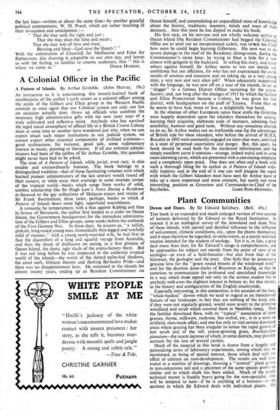William IV and His Times
-
Tun reign of William IV has never attracted from posterity even one-tenth of the curiosity aroused by the lives and reigns of his predecessor, George IV, or his successor, Victoria. Yet the con- clusion " A very dull reign "—although, like the official inscription, " Dead Slow," at the carriage entrance to the House of Lords, it is a tempting verdict—is really too facile a judgement (in both cases) to be sustained on mature consideration. Certainly William had a disappointingly heavy touch in his personal relations—the parting from the love of his life, Mrs. Jordan, and her subsequent death, though he did feel them, seem to have had as little outward effect on him-as a wooden spoon in the Christmas pudding. But, if we cannot often laugh with him, we can often laugh at him, and with some degree of affectionate sympathy. If we deplore the irregularity of his private life, we must still note with interest that the reason for his separation from a young lady named Polly Finch was that he would insist on reading The Lives of the Admirals aloud to her. He was a good sea-captain " Superior to near two-thirds of the list," said Nelson. And when he came to the throne his solid dependability - that was his best characteristic ensured that he did not falter. He signed all the 48,000 signatures " my poor brother should have signed," even though they gave him cramp. He became popular with his people, and, as Madame von Billow said, he was" altogether such a cheerful King."
It Was an excellent idea of Dr. Trevelyan's to make a book- out of sixty-two of the Political Sketches by John Doyle (" H. B.") which were published during William's reign. There could probably be no better or more congenial way of comprehending the intricacies of the battle for Reform—in which the King took such a decisive part—than by studying these plates, which have been very well reproduced in collotype, and by reading the introduction and running commentary which Dr. Trevelyan has provided with his usual perspicuity and economy. John Doyle was not nearly so gifted or entertaining a draughtsman as his famous son, Richard (of Punch).
Much of his drawing is simply lifeless repetition ; his drain-pipe trousers look as if they had been bought " off the peg " by the score. There is no trace in John Doyle's work of the robust satire, and the sense of indignant moral purpose, with which Hogarth, followed by Rowlandson, Gillray and Cruikshank, had established a tradition of English caricature. With the approach of Victorian " respectability," this aggressive vitality departed from our cari- catures and went abroad, to appear in the drawings of Daumier and Gavarni, of Steinlen and -Raemakers, and eventually to be re- stored to us in our own time by David Low. But " H. B." introduced something quite different, and not without its own quiet merits, a good-humoured urbanity and detachment which directly influenced the line and methods of Tenniel, Carruthers-Gould, Partridge and " Poy." Even though the fun was mild, it was a distinct advantage, as Dr. Trevelyan points out, to have the leading popular cartoonist " during the fierce faction fights of the Reform Bill " setting such a well-mannered example.
John Doyle, with his imperturbable detachment, successfully avoided the reproach of pomposity which was a lurking threat to the cartoons of Tenniel and Partridge, and I think his work has more of the feeling of F. C. G.'s Westminster Cartoons. His John Bull, as Dr. Trevelyan says, " is perhaps the last entirely-satisfactory ' appearance of that symbolic personage in art." He had the gift of getting a good likeness, and his leading characters, Wellington, Brougham, Grey and William IV himself, with his head like a pineapple, are very well done. Among many insipidities, there are some brilliant surprises, including an admirable parody of a Landseer picture. "H. B." was much addicted to balloons issuing from the mouths of his characters. Some of this dialogue was ingenious. Brougham, for example, was notoriously associated with The Times under Thomas Barnes, until they quarrelled, and, while introducing Brougham in the guise of a prisoner to two magistrates (the King and John Bull), Peel is made to say : " Please your worship the Prisoner at the Bar is accused of incendiarism—He was often strongly suspected in Times ' past of inserting inflammable matter in the night, his progress every where being marked by Columns of smoke ; but we have positive evidence of his having within the last few months actually set Barnes on fire ! " The best drawings are the first, which shows Brougham as a sun- worshipper hailing the rising sun of William IV apck aring above the horizon, and the last—a youthful and charming Queen Victoria, riding on horseback into an uncertain future between her Prime Minister and her Foreign Secretary. It calls to mind some of the last lines—written at about the same time—by another gracefie political commentator, W. M. Praed, which are rather touching ui
their invocation and anticipation :— - " That she may seek the right and just ; That she may shun the false and mean ; That she may win all love and trust, Blessing and blest—God save the Queen ! " With the substitution of Churchill for Melbourne and Eden for Palmerston, this drawing is adaptable to our own day, and leaves us with the feeling, so familiar to cinema audiences, that " this is



































 Previous page
Previous page